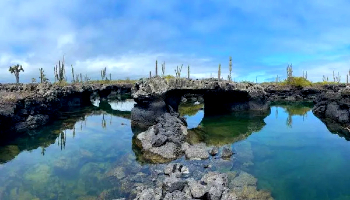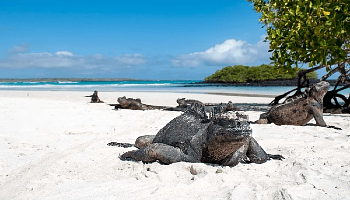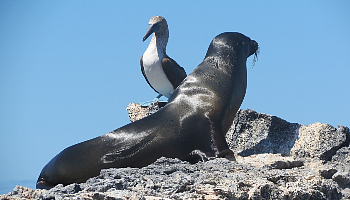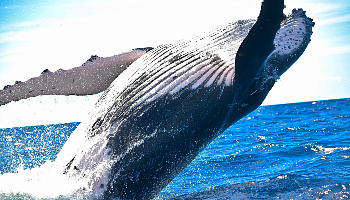The Galápagos Islands, a UNESCO World Heritage site, are a paradise for nature enthusiasts and adventure seekers alike. Located in the Pacific Ocean, this Ecuadorian archipelago is a treasure trove of natural wonders and unique experiences. From exploring volcanic landscapes and underwater worlds to observing rare wildlife, each activity offers a deeper connection to this remarkable archipelago. Whether you’re an adventure seeker, a nature lover, or simply looking to unwind in a pristine environment, the Galápagos Islands provide an unforgettable travel experience. Here are the top 10 activities that should be on every traveler’s list.
1. Snorkeling at Devil’s Crown
 Devil’s Crown, a submerged volcanic crater near Floreana Island, is a top snorkeling destination in the Galápagos. The vibrant underwater world here includes colorful coral reefs, a myriad of fish species, and the occasional sighting of sea turtles and sharks. The swift currents and clear waters make it an exhilarating experience for snorkelers of all levels. Besides the underwater wonders, the jagged remnants of the volcanic cone rising above the surface create a dramatic backdrop. This natural aquarium offers a glimpse into the rich marine biodiversity that the Galápagos are famous for.
Devil’s Crown, a submerged volcanic crater near Floreana Island, is a top snorkeling destination in the Galápagos. The vibrant underwater world here includes colorful coral reefs, a myriad of fish species, and the occasional sighting of sea turtles and sharks. The swift currents and clear waters make it an exhilarating experience for snorkelers of all levels. Besides the underwater wonders, the jagged remnants of the volcanic cone rising above the surface create a dramatic backdrop. This natural aquarium offers a glimpse into the rich marine biodiversity that the Galápagos are famous for.
2. Visiting the Charles Darwin Research Station
 Situated on Santa Cruz Island, the Charles Darwin Research Station is a hub of scientific research and conservation efforts. Visitors can learn about the vital work being done to preserve the unique flora and fauna of the islands, including the famous giant tortoises. The station’s breeding programs have been instrumental in the recovery of several endangered species. Interactive exhibits and informative displays provide insights into the evolutionary processes that inspired Darwin’s theory of natural selection. A visit here not only educates but also highlights the importance of ongoing conservation initiatives.
Situated on Santa Cruz Island, the Charles Darwin Research Station is a hub of scientific research and conservation efforts. Visitors can learn about the vital work being done to preserve the unique flora and fauna of the islands, including the famous giant tortoises. The station’s breeding programs have been instrumental in the recovery of several endangered species. Interactive exhibits and informative displays provide insights into the evolutionary processes that inspired Darwin’s theory of natural selection. A visit here not only educates but also highlights the importance of ongoing conservation initiatives.
3. Hiking Sierra Negra Volcano
 Sierra Negra, on Isabela Island, offers one of the most rewarding hikes in the Galápagos. The trek to the summit takes you through diverse landscapes, from lush highland vegetation to stark volcanic terrain. Once at the top, hikers are greeted with a breathtaking view of the world’s second-largest volcanic crater, stretching over six miles in diameter. On clear days, you can see the steaming fumaroles and the expansive lava fields that showcase the geological forces shaping the islands. This hike is a must for those looking to experience the raw power of nature.
Sierra Negra, on Isabela Island, offers one of the most rewarding hikes in the Galápagos. The trek to the summit takes you through diverse landscapes, from lush highland vegetation to stark volcanic terrain. Once at the top, hikers are greeted with a breathtaking view of the world’s second-largest volcanic crater, stretching over six miles in diameter. On clear days, you can see the steaming fumaroles and the expansive lava fields that showcase the geological forces shaping the islands. This hike is a must for those looking to experience the raw power of nature.
4. Exploring the Tunnels of Los Tuneles
 Also located on Isabela Island, Los Tuneles features a network of lava tunnels and arches partially submerged by the ocean. These natural formations create a maze-like habitat for marine life, making it a premier spot for snorkeling. Here, you can swim alongside sea turtles, reef sharks, and rays, while the calm waters provide excellent visibility. The tunnels and arches above the water add an otherworldly charm to the setting, making it a photographer’s dream. This unique environment offers a rare opportunity to explore underwater lava formations and their inhabitants.
Also located on Isabela Island, Los Tuneles features a network of lava tunnels and arches partially submerged by the ocean. These natural formations create a maze-like habitat for marine life, making it a premier spot for snorkeling. Here, you can swim alongside sea turtles, reef sharks, and rays, while the calm waters provide excellent visibility. The tunnels and arches above the water add an otherworldly charm to the setting, making it a photographer’s dream. This unique environment offers a rare opportunity to explore underwater lava formations and their inhabitants.
5. Observing Wildlife at North Seymour Island
 North Seymour Island is a haven for wildlife enthusiasts. The island is home to a large colony of blue-footed boobies, whose charming mating dance is a highlight for visitors. Frigatebirds, with their impressive red throat pouches, can also be seen nesting here. Along the rugged coastline, sea lions bask in the sun, and marine iguanas scuttle over the rocks. The island’s diverse habitats support a variety of species, making it a microcosm of Galápagos biodiversity. Guided tours provide in-depth knowledge about the island’s ecology and the behaviors of its inhabitants.
North Seymour Island is a haven for wildlife enthusiasts. The island is home to a large colony of blue-footed boobies, whose charming mating dance is a highlight for visitors. Frigatebirds, with their impressive red throat pouches, can also be seen nesting here. Along the rugged coastline, sea lions bask in the sun, and marine iguanas scuttle over the rocks. The island’s diverse habitats support a variety of species, making it a microcosm of Galápagos biodiversity. Guided tours provide in-depth knowledge about the island’s ecology and the behaviors of its inhabitants.
6. Discovering Lava Formations at Sullivan Bay
 Sullivan Bay on Santiago Island is famous for its dramatic lava fields, formed during an eruption in the late 19th century. Walking across the hardened lava flows feels like stepping onto another planet, with intricate patterns and formations created by the cooling lava. The stark black landscape is sporadically punctuated with pioneer plants, showing the first stages of ecological succession. This area offers a fascinating insight into the volcanic activity that has shaped the Galápagos Islands. It’s a stark reminder of the powerful geological forces at work in this region.
Sullivan Bay on Santiago Island is famous for its dramatic lava fields, formed during an eruption in the late 19th century. Walking across the hardened lava flows feels like stepping onto another planet, with intricate patterns and formations created by the cooling lava. The stark black landscape is sporadically punctuated with pioneer plants, showing the first stages of ecological succession. This area offers a fascinating insight into the volcanic activity that has shaped the Galápagos Islands. It’s a stark reminder of the powerful geological forces at work in this region.
7. Kayaking in Tortuga Bay
 Tortuga Bay, located on Santa Cruz Island, is a pristine beach renowned for its soft, white sand and turquoise waters. It’s an ideal spot for kayaking, offering a serene way to explore the coastal environment. Paddling through the calm waters, you can encounter marine iguanas, rays, and even sharks in the shallows. The bay is also a nesting site for the black turtle, providing an opportunity to observe these creatures in their natural habitat. The tranquil setting and abundant wildlife make kayaking here a peaceful yet thrilling experience.
Tortuga Bay, located on Santa Cruz Island, is a pristine beach renowned for its soft, white sand and turquoise waters. It’s an ideal spot for kayaking, offering a serene way to explore the coastal environment. Paddling through the calm waters, you can encounter marine iguanas, rays, and even sharks in the shallows. The bay is also a nesting site for the black turtle, providing an opportunity to observe these creatures in their natural habitat. The tranquil setting and abundant wildlife make kayaking here a peaceful yet thrilling experience.
8. Diving at Gordon Rocks
 Gordon Rocks, often referred to as the “washing machine” due to its strong currents, is a premier dive site near Santa Cruz Island. This spot is famous for its encounters with hammerhead sharks, which can be seen schooling in large numbers. The rocky pinnacles also attract other marine life, including rays, sea lions, and a variety of fish species. The challenging conditions make it suitable for experienced divers, who are rewarded with some of the most exhilarating underwater scenes in the Galápagos.
Gordon Rocks, often referred to as the “washing machine” due to its strong currents, is a premier dive site near Santa Cruz Island. This spot is famous for its encounters with hammerhead sharks, which can be seen schooling in large numbers. The rocky pinnacles also attract other marine life, including rays, sea lions, and a variety of fish species. The challenging conditions make it suitable for experienced divers, who are rewarded with some of the most exhilarating underwater scenes in the Galápagos.
9. Visiting Española Island
 Española Island, one of the oldest in the archipelago, is a hotspot for birdwatchers. It’s the only place in the Galápagos where you can see the waved albatross, especially during their breeding season from April to December. The island’s Punta Suarez trail offers spectacular views and close encounters with a variety of bird species, including Nazca boobies and mockingbirds. And Gardner Bay boasts a stunning beach that is frequented by sea lions. The combination of unique wildlife and beautiful landscapes makes Española Island a must-visit.
Española Island, one of the oldest in the archipelago, is a hotspot for birdwatchers. It’s the only place in the Galápagos where you can see the waved albatross, especially during their breeding season from April to December. The island’s Punta Suarez trail offers spectacular views and close encounters with a variety of bird species, including Nazca boobies and mockingbirds. And Gardner Bay boasts a stunning beach that is frequented by sea lions. The combination of unique wildlife and beautiful landscapes makes Española Island a must-visit.
10. Whale Watching at Isabela Island
 Isabela Island, the largest in the archipelago, provides excellent opportunities for whale watching. Between June and September, humpback whales migrate through the waters around the island, and sightings are common during boat tours. In addition to humpbacks, it’s possible to see orcas, pilot whales, and even blue whales. The sight of these majestic creatures breaching and playing in the ocean is unforgettable. Whale watching in the Galápagos offers a chance to witness these magnificent animals in their natural environment, adding a sense of wonder to any visit.
Isabela Island, the largest in the archipelago, provides excellent opportunities for whale watching. Between June and September, humpback whales migrate through the waters around the island, and sightings are common during boat tours. In addition to humpbacks, it’s possible to see orcas, pilot whales, and even blue whales. The sight of these majestic creatures breaching and playing in the ocean is unforgettable. Whale watching in the Galápagos offers a chance to witness these magnificent animals in their natural environment, adding a sense of wonder to any visit.
Photo Credits:
Lead – galapagosislands.net
Devil’s Crown – galapagosislands.net
Charles Darwin Research Station – Unsplash
Sierra Negra Volcano – Wikimedia – by Adavyd, Creative Commons Attribution-Share Alike 4.0 International
Tortuga Bay – Shutterstock free trial
Sullivan Bay – Freepik
Gordon Rocks – Pixabay
Espanola Island – Wikipedia – by David Broad, Creative Commons Attribution 3.0 Unported
Whale Watching Isabela Island – Pixabay


